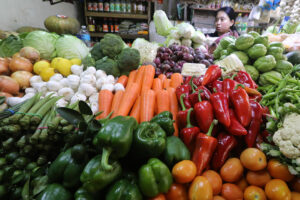Sept. inflation likely eased to 2.5% — Recto
PHILIPPINE INFLATION would likely ease to 2.5% this month, giving the central bank room to cut interest rates more than expected, Finance Secretary Ralph G. Recto said on Tuesday. But the government remains cautious as the escalating conflict in the Middle East could lead to a spike in global oil prices, he said. “Inflation is […]

PHILIPPINE INFLATION would likely ease to 2.5% this month, giving the central bank room to cut interest rates more than expected, Finance Secretary Ralph G. Recto said on Tuesday.
But the government remains cautious as the escalating conflict in the Middle East could lead to a spike in global oil prices, he said.
“Inflation is on a downward trend,” Mr. Recto, fresh from a Cabinet meeting on managing food and nonfood inflation, said at a Palace briefing. “We expect inflation to go down to 2.5% by September.”
September inflation data will be released on Oct. 4.
Mr. Recto said the Bangko Sentral ng Pilipinas (BSP) can further reduce interest rates and match the size of the US Federal Reserve’s jumbo rate cut.
“The Fed cut by 50 basis points (bps) or half a percent, I think, we can also do half a percent,” he said in mixed English and Filipino.
BSP Governor Eli M. Remolona, Jr. earlier said that they could cut by another 25 bps in the fourth quarter.
Easing inflation had prompted the BSP to begin its easing cycle at its Aug. 15 meeting. The Monetary Board cut rates by 25 bps, bringing the benchmark rate to 6.25% from the over 17-year high of 6.5%. This was the first time the BSP reduced rates since November 2020.
Headline inflation slowed year on year to a seven month low of 3.3% in August, from 4.4% in July, due to a moderate rise in food prices and a decline in transport costs.
Year to date, inflation rose by 3.6%, slower than 6.6% a year ago.
Mr. Recto said inflation could average 3.4% this year, and further ease to 2.9-3.1% in 2025.
The BSP last month adjusted its baseline inflation forecasts to 3.4% for 2024 (from 3.3% previously), 3.1% for 2025 (from 3.2% previously), and 3.2% for 2026 (from 3.3% previously).
“The beauty about reducing inflation is that your gross domestic product (GDP) growth goes up and more jobs can be created, your borrowing cost goes down,” Mr. Recto said.
He said the possible rate cut will boost the Philippines’ chance of hitting its 6.5-7.5% growth target for 2025.
However, Mr. Recto said the tensions in the Middle East threaten the government’s inflation expectations, noting that global oil prices could spike if a war breaks out.
“Our biggest challenge is external headwinds. One is the war in the Middle East, and we don’t want that to go out of hand and possibly lead to oil price increases,” Mr. Recto said, referring to the escalation in the conflict between Israel and Lebanon’s Hezbollah.
“There is also a pressure for electricity prices to go up,” he added.
Meanwhile, Diwa C. Guinigundo, country analyst for the Philippines of GlobalSource Partners, said geopolitical conflicts “could trigger a possible escalation in oil prices, energy and food prices and ultimately, inflation.”
“With inflation showing some easing trend, within-target inflation forecasts and the balance of risks tilting to the downside, there is definitely some scope for further accommodation by the BSP,” he told BusinessWorld.
Asked to comment on Mr. Recto’s statements, the former BSP deputy governor said: “I would expect our fiscal authorities to avoid speaking on monetary policy especially on matters of inflation forecasts and the likely direction of monetary policy, as well as providing some sort of forward guidance to the market.
Security Bank Corp. Chief Economist Robert Dan J. Roces said external threats, particularly conflicts in the Middle East and global oil prices, are still “significant concerns.”
“While these projections signal effective anti-inflation measures, the true test lies in translating lower inflation into tangible benefits for ordinary citizens through job creation, improved social services, and sustainable economic practices,” Mr. Roces said in a Viber message.
Leonardo A. Lanzona, who teaches economics at Ateneo de Manila University, said the government appears to be forgetting that the recent inflation has been fueled by food prices, not external factors.
“This has to do more with internal management of the economy. Unless food, especially rice, prices are controlled, the inflation risks remain,” he said in a Facebook Messenger chat.
At the Tuesday briefing, Agriculture Secretary Francisco Tiu Laurel said the pressure on pork prices will likely ease as the government rolls out vaccines for African Swine Fever, which has forced producers to cull hogs.
The government has tested the vaccines locally with 10,000 doses, he noted, adding that the next 450,000 doses will be awarded next month.
“We hope to complete the procurement of 600,000 doses by the end of December this year,” he said.
EXCESS LIQUIDITY
Meanwhile, Mr. Guinigundo said the government should keep a close eye on the potential excess in liquidity following the lifting of banks’ reserve requirement ratio (RRR) by 250 bps.
“(This) could add nearly P500 billion in domestic liquidity. With a small negative output gap, we would not want to dissipate that window and risk a potential resurgence in inflation due to additional liquidity injection,” he said.
“What is supporting this monetary stance by the BSP is the favorable inflation expectations even following the recent reduction in both the policy rate and the RRR,” he added.
At the Palace briefing, Mr. Recto, a member of the Monetary Board, said the BSP had considered the RRR cut’s potential impact on inflation.
“We’ve considered that when we decided on the policy in the last BSP meeting. This will be good for the economy. It will improve the capital markets,” he said. “We’re injecting roughly P380 billion into the system. It will be good for banks. And then, it will have a lag effect.”
The BSP will reduce the RRR for big banks and nonbank financial institutions with quasi-banking functions by 250 bps to 7% from 9.5% previously, effective Oct. 25.
It will also reduce the ratio for digital banks by 200 bps to 4%, thrift banks by 100 bps to 1%, and rural banks and cooperative banks by 100 bps to 0%. — Kyle Aristophere T. Atienza












